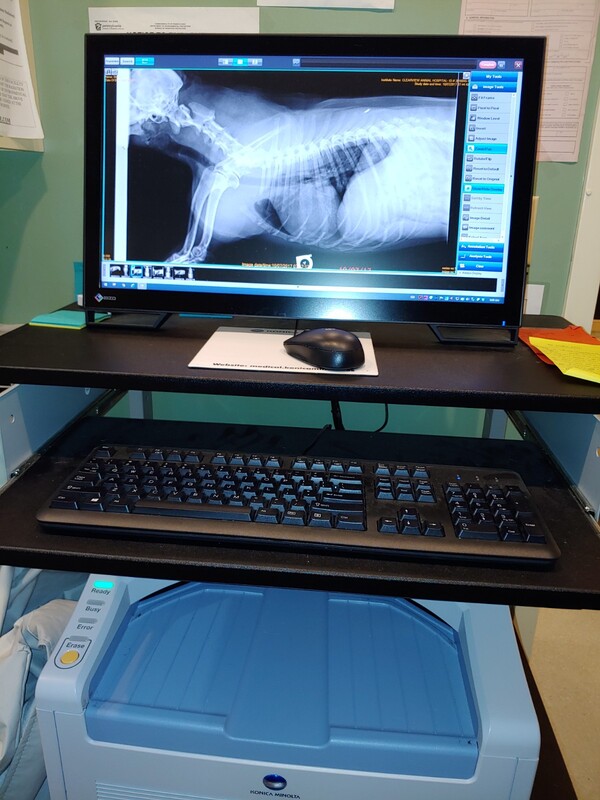RADIOLOGY

Radiography is a valuable diagnostic tool in veterinary medicine. As we continually strive to offer the highest quality medicine and diagnostic testing, we are pleased to offer digital radiology services as a means of providing fast results and excellent care to our patients.
My pet ate what??? Radiographs are often taken when we suspect (or know) that your pet has eaten something -- like your good earrings!!! Things like metal and rock will show up very well on an x-ray, but other things (like socks and rubber) may not be seen at all.
A radiograph (sometimes called an x-ray) is a type of photograph that can look inside the body and reveal information that may not be discernable from the outside. Radiography can be used to evaluate almost any organ in the body, including the heart, lungs, and abdominal organs, as well as the bones.
Radiography is painless, safe, and completely non-invasive, and it uses only very low doses of radiation. Because the level of radiation exposure needed to perform radiography is very low, even pregnant females and very young pets can undergo radiography. Radiographs can be used to evaluate bones as well as the size, shape, and position of many of the body's organs. The size of organs is important because some medical conditions, such as kidney, heart, or liver disease, can alter the size of these organs. The shape and position of organs can be altered or distorted by certain medical conditions, including intestinal blockage or cancer. Tumors, depending on their size and location, can also sometimes be detected using radiography. Radiography can also be used to diagnose bladder stones, broken bones, chronic arthritis, certain spinal cord diseases, and a variety of other conditions.
Radiographs are an important tool that can help us make a correct diagnosis for your pet. Our veterinarians may recommend a radiograph at the time of your pet's physical exam if there is something out of the ordinary discovered during the exam or if your pet is ill. In some cases, we may recommend sedation for your pet in order to get the best "picture" possible.
Feel free to call our receptionists if you have questions or feel that your pet may need an x-ray.
My pet ate what??? Radiographs are often taken when we suspect (or know) that your pet has eaten something -- like your good earrings!!! Things like metal and rock will show up very well on an x-ray, but other things (like socks and rubber) may not be seen at all.
A radiograph (sometimes called an x-ray) is a type of photograph that can look inside the body and reveal information that may not be discernable from the outside. Radiography can be used to evaluate almost any organ in the body, including the heart, lungs, and abdominal organs, as well as the bones.
Radiography is painless, safe, and completely non-invasive, and it uses only very low doses of radiation. Because the level of radiation exposure needed to perform radiography is very low, even pregnant females and very young pets can undergo radiography. Radiographs can be used to evaluate bones as well as the size, shape, and position of many of the body's organs. The size of organs is important because some medical conditions, such as kidney, heart, or liver disease, can alter the size of these organs. The shape and position of organs can be altered or distorted by certain medical conditions, including intestinal blockage or cancer. Tumors, depending on their size and location, can also sometimes be detected using radiography. Radiography can also be used to diagnose bladder stones, broken bones, chronic arthritis, certain spinal cord diseases, and a variety of other conditions.
Radiographs are an important tool that can help us make a correct diagnosis for your pet. Our veterinarians may recommend a radiograph at the time of your pet's physical exam if there is something out of the ordinary discovered during the exam or if your pet is ill. In some cases, we may recommend sedation for your pet in order to get the best "picture" possible.
Feel free to call our receptionists if you have questions or feel that your pet may need an x-ray.


